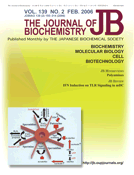-
Views
-
Cite
Cite
Myung Hee Park, The Post-Translational Synthesis of a Polyamine-Derived Amino Acid, Hypusine, in the Eukaryotic Translation Initiation Factor 5A (eIF5A), The Journal of Biochemistry, Volume 139, Issue 2, February 2006, Pages 161–169, https://doi.org/10.1093/jb/mvj034
Close - Share Icon Share
Abstract
The eukaryotic translation initiation factor 5A (eIF5A) is the only cellular protein that contains the unique polyamine-derived amino acid, hypusine [Nε-(4-amino-2-hydroxybutyl)lysine]. Hypusine is formed in eIF5A by a novel post-translational modification reaction that involves two enzymatic steps. In the first step, deoxyhypusine synthase catalyzes the cleavage of the polyamine spermidine and transfer of its 4-aminobutyl moiety to the ε-amino group of one specific lysine residue of the eIF5A precursor to form a deoxyhypusine intermediate. In the second step, deoxyhypusine hydroxylase converts the deoxyhypusine-containing intermediate to the hypusine-containing mature eIF5A. The structure and mechanism of deoxyhypusine synthase have been extensively characterized. Deoxyhypusine hydroxylase is a HEAT-repeat protein with a symmetrical superhelical structure consisting of 8 helical hairpins (HEAT motifs). It is a novel metalloenzyme containing tightly bound iron at the active sites. Four strictly conserved His-Glu pairs were identified as iron coordination sites. The structural fold of deoxyhypusine hydroxylase is entirely different from those of the other known protein hydroxylases such as prolyl 4-hydroxylase and lysyl hydroxylases. The eIF5A protein and deoxyhypusine/hypusine modification are essential for eukaryotic cell proliferation. Thus, hypusine synthesis represents the most specific protein modification known to date, and presents a novel target for intervention in mammalian cell proliferation.





